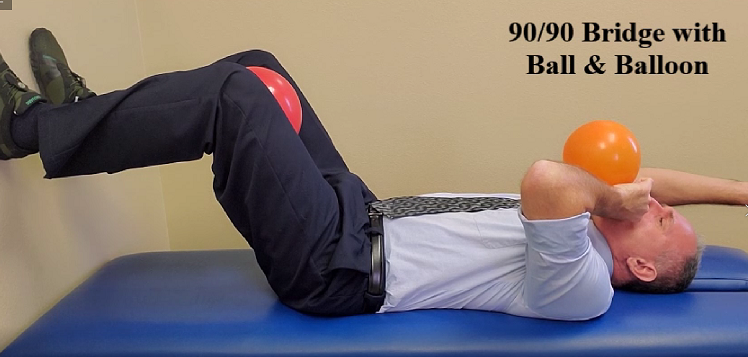Execute isometric abdominal strengthening exercises to develop strength and endurance in the deep core muscles including the transverse abdominis, diaphragm and multifidi. Strengthen your deep abdominal muscles to help lower the potential of low back pain. Strong transverse abdominis, diaphragm and multifidi muscles are needed for spinal stability. If the deep muscles do not stabilize the spine the large erector spinae muscles are forced to carry a greater workload. Combine deep abdominal strengthening exercises with lumbar spine stretching exercises to combat postural issues such as lower cross syndrome. Powerful deep core muscles lower the potential of painful and performance limiting conditions such as adductor strains, hamstrings strains and proximal hamstrings tendinopathy.
Abdominal Drawing-In Maneuver (ADIM)
Supine. Hips flexed. Knees flexed. Feet flat on floor.
Throughout entire exercise pelvis, hips and ribcage should not move.
Pull umbilicus directly posterior, toward lumbar spine, as deep as possible.
Maintain isometric contraction while breathing lightly.
Hold eight seconds.
Can be performed in four positions: Supine, sitting, standing and quadruped.
Build to thirty repetitions in each position.
Patient supine position. Hips and knees flexed. Feet flat on floor.
Place both hands under lumbar spine or on sides of pelvis.
Flex abdominal muscles to rotate pelvis and move pubic symphysis superiorly toward umbilicus.
Hold isometric contraction for two to six seconds.
Intermediate and Advanced: Use a variety of arm and leg positions.
Advanced: Perform in standing or kneeling positions.
90/90 Bridge with Ball and Balloon
Patient supine. Bilateral hips and knees flexed ninety degrees. Feet flat on wall. Small ball held between knees or distal thighs.
Small balloon held in one hand. Opposite shoulder flexed about one hundred and eighty degrees.
Inhale through nose. Exhale through mouth. Perform a pelvic tilt. Engage hamstrings and gluteus maximus.
Maintain this position for the remainder of the exercise.
Inhale through nose and slowly blow into balloon.
Pause three seconds with your tongue positioned on roof of mouth to prevent airflow out of balloon.
Without pinching neck of balloon and keeping tongue on roof of mouth, inhale again through nose. Slowly blow out as you stabilize the balloon. Do not strain your neck or cheeks as you blow.
After fourth breath in, pinch balloon neck and remove it from mouth. Let air out of balloon.
Relax and repeat sequence four more times.
Strengthen the deep core muscles (transverse abdominis, multifidi and diaphragm) with isometric exercises to develop a powerful core, decrease the potential of lower back injuries and rehabilitate lumbar spine conditions. Perform all exercises through a symptom free range of motion. Never execute an exercise that elicits or intensifies symptoms. If an exercise elicits or intensifies symptoms, stop immediately and find a viable substitute. Increase intensity in small gradual calculated increments.
THE VALUE OF BLOWING UP A BALLOON
https://www.ncbi.nlm.nih.gov/pmc/articles/PMC2971640
The effects of abdominal draw-in maneuver and core exercise on abdominal muscle thickness and Oswestry disability index in subjects with chronic low back pain
https://www.ncbi.nlm.nih.gov/pmc/articles/PMC3836508/
Anatomy, Back, Muscles https://www.ncbi.nlm.nih.gov/books/NBK537074/
Does a core stabilization exercise program have a role on shoulder rehabilitation? A comparative study in young females https://www.ncbi.nlm.nih.gov/pmc/articles/PMC6648025/
Disclaimer: Viewing this video does not take the place of seeing a medical professional, receiving proper training in the medical profession or working with a fitness professional. Please visit a medical professional for evaluation, diagnosis and treatment. Please work with a fitness professional to learn proper exercise technique and to develop a proper training program. Never perform an exercise that elicits or intensifies symptoms. If an exercise elicits or intensifies symptoms, stop immediately and use a viable substitute. Please receive proper medical training before attempting these medical procedures.
Dr Donald A Ozello DC of Championship Chiropractic in Las Vegas, NV
Web Site: http://www.championshipchiropractic.com/
Blog: https://www.championshipchiropractic.com/wordpress/
Twitter: https://twitter.com/drdozellodc
Facebook: https://www.facebook.com/Championship-Chiropractic-280141628688300/
LinkedIn: https://www.linkedin.com/in/dr-donald-a-ozello-dc-716b3233
YouTube: https://www.youtube.com/user/drdozellodc/videos
“Running: Maximize Performance & Minimize Injuries” https://www.amazon.com/Running-Performance-Chiropractors-Minimizing-Potential/dp/1493618741

